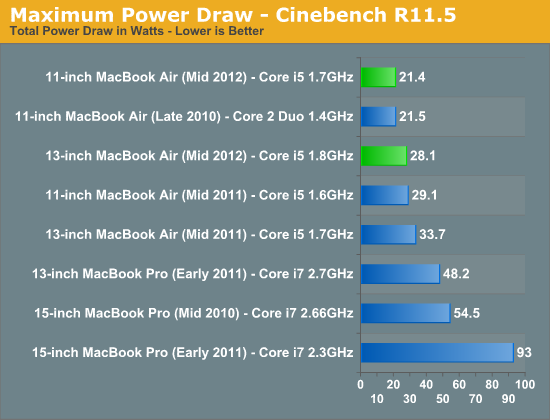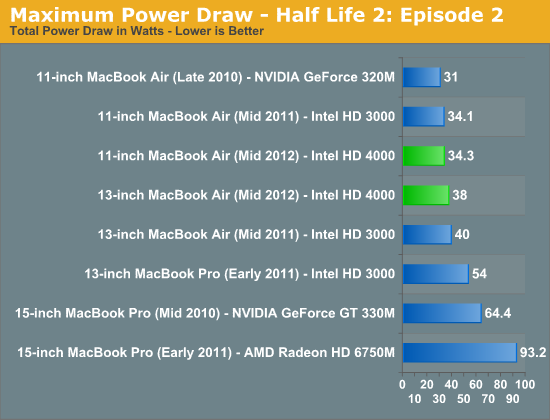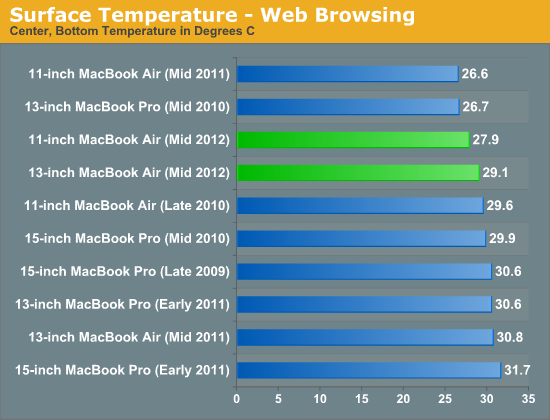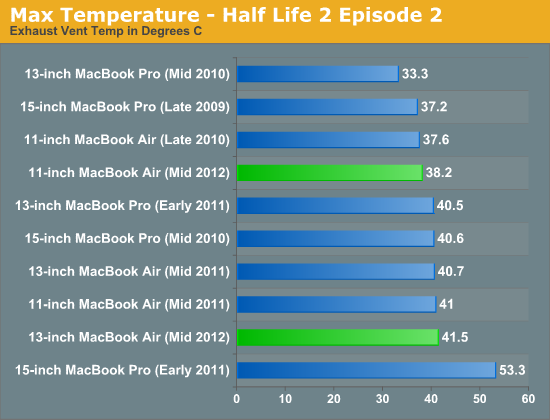The 2012 MacBook Air (11 & 13-inch) Review
by Anand Lal Shimpi on July 16, 2012 12:53 PM EST- Posted in
- Apple
- Mac
- MacBook Air
- Laptops
- Notebooks
Power Consumption & Thermals
I dug up my old power draw and thermal numbers from the 2011 MacBook Air review, retested the old models to ensure they still performed as expected, and added the 2012 models to the list.
First up is power consumption. Here we're measuring total system power consumption with the display running at max brightness and the battery fully charged. We are forced to use a different power adapter for the 2012 MacBook Airs so there may be some variance here but the power rating remains the same.

Cinebench shows a real reduction in power consumption under load. This is exactly what we expect to see from Ivy Bridge, which should translate into better battery life numbers.

The power savings are basically non-existant under HL2ep2, but you have to keep in mind that the HD 4000 is able to deliver over 70% better performance at roughly the same power level as the HD 3000.
Surface temperatures haven't changed all that much, at idle the 11-inch system measured a bit cooler than its predecessor while the 13 was within a degree.

Under load these things can get hot - despite the power savings it looks like the base of the chassis gets roughly as warm as it did last year. There's only so much you can do with a tiny chassis and a single fan. Note that during my Diablo III benchmarking pass I measured 45C just north of the F2 key on the keyboard on the 13-inch MBA.











190 Comments
View All Comments
robco - Wednesday, July 18, 2012 - link
I have a few friends who upgraded to the new Airs and love them. I'm holding onto my 3 year old MBP for another year until Haswell comes out. Though it looks like the HD 4000 can keep up with or even surpass the 9600M in mine.I'm leaning toward the Air, though my personal prediction (hope?) is that when Haswell comes out next year, that will have enough oomph for Apple to launch the 13" rMBP with a 2560x1600 display. If they can keep the weight under 4 lbs., that would be awesome.
As for Apple not being the first, being first isn't always best. There were other ultraportables before the 2010 Air, but few sold in large volume. There were tablets before the iPad, but relatively few sales. There were smartphones before the iPhone, but few consumers wanted them. Being first isn't important, executing a good product is.
And for the anecdotal stories, how a company handles a problem is also quite important. I'm on my second Apple laptop, but each one has had issues (I get AppleCare). On my 2006 MB, the trim started pulling away, made an appointment at the Apple Store, they replaced the top case the same day. A week before AppleCare expired, I noticed the optical drive had failed (never really used it), they not only replaced it, but found that one of the cooling fans wasn't operating quite as fast as it should, they replaced that too. When I got my 2009 MBP, the trackpad started sticking and wouldn't click, fixed same day. I got a battery error, that was replaced in about 20 mins. No waiting on hold for hours, going through a bunch of repetitive nonsense. Fixed quickly, no questions asked. I don't expect to never have an issue, I'm hardly gentle with my laptops, but when something does happen, it's nice to know things get fixed quickly without a lot of hassle. Then again, that's just my own personal experience...
MobiusStrip - Wednesday, July 18, 2012 - link
Yay, more Apple computers with mandatory, shitty glossy screens.What kind of "leader" takes its cues from the third-tier plastic schlock being peddled at Best Buy? Glossy screens are the biggest regression in computing ever. Absolutely moronic.
Deepcover96 - Wednesday, July 18, 2012 - link
I hadn't noticed that my 2012 MacBook Air's screen was glossy. Maybe they made it less glossy?phillyry - Tuesday, March 26, 2013 - link
Maybe they made them extra glossy on purpose so that we wouldn't be able to notice the terrible viewing angles for all the glare!phillyry - Thursday, March 28, 2013 - link
Also helps to hide the pixelation.Lepton87 - Wednesday, July 18, 2012 - link
I have something to say regarding anand's conclusion that 1920x1200 on a 11' is a stopgap solution and apple is too great to settle for something so mediocre. 2732x1536 on the 11.6 is totally idiotic. You don't need more than 120PPI on a desktop and 140PPI on a laptop for a screen to be considered retina.(remember viewing distance is a big factor) So why waste all that processing power? Even retina Macbook pro can't render everything silky smooth. Even my 2560x1440 desktop 27'' "lowly" resolution screen is 90% retina, taking into account my less than perfect eyesight into equation it's probably very close all that I need to not seen individual pixels from normal viewing distance. 2880x1800 on 27' would make it a perfect screen for my, everthing more than that would choke my already outdated quadfire 2x6990 CF set-up. The boss probably won't honor me with answering this personally :( I would really like to know his view on increasing resolution way past what would be considered retina, i.e making pixels much smaller than the necessary size for them to be not discernible individually from normal viewing distance.Znarkus - Thursday, July 19, 2012 - link
It would've been awesome to compare max power draw and surface temperature with the different CPUs, especially the i7 :)Alameda - Saturday, July 21, 2012 - link
I have a 2011 MacBook Air. I think the big improvement in 2012 is USB 3. Time Machine backups take a very long time (I backup once every few days). USB 3 would clearly make a big difference here. Thunderbolt, sadly, is too expensive to justify, unless you're backing up to a RAID or some such.Galatian - Sunday, July 22, 2012 - link
Hey Anand,I have yet to get back to you again concerning the Gaming Performance on the i5 ULV with HD4000. I was coming from a 2008 Unibody MacBook Pro (2,53 GHz, 8 GB RAM, Vertex 2, nVidia 9600M 512 MB vRAM), so I naturally expected that Civilization V would not run as fast on my new MacBook Air under Windows than it did on my old MacBook Pro. At least your charts suggest so. According to FRAPS I would get around 22 fps, which is not stellar but enough for turn based strategy game.
I don't know if there has been any update on the driver or what, but Civilization V is actually more playable on my MacBook Air then on my old MacBook Pro. The CPU of course is faster. My MacBook Pro would overheat and hence the Core 2 Duo only ran with like 2,0 GHz while playing the game, while the Ivy Bridge ULV actually still has enough headroom to Turbo Boost. The big surprise to me was actually the graphic performance, which has been much smoother. For the sake of it I would really like to know how you get your extremely low fps while testing Civilization V? Are you running the newest version w/o Gods & Kings add-on? Do other persons have the same experience? I thought I would make a step back in gaming performance when I switched to the MacBook Air, but to my surprise this isn't the case. I sure would like other people to know this, so they can put the Ivy Bridge ULV in better perspective.
Along the line I would really like to see a comparison between AMDs and Intels ULV offerings. The tests I see only only compare the A10 (which has a much higher TDP) to Intels ULV platform. From my understanding only the Bobcat should be comparable to Intels ULV offering. Then again I really can't follow what is what with AMD especially I don't which ones are released and which ones are not...
cookiezulu - Monday, July 30, 2012 - link
Hi Anand, thank you for yet another excellent review! I was worried for a sec there that you might be busy with other things and skip the review for the MBA this year.The MBA 2012 (8GB, stock processor) is my first ever MAC and also my first computer with an SSD drive. I'm not very familiar with how the SD Card slots work in these SSD machines and/or in Mac machines and I would like to buy one of these:
http://www.kickstarter.com/projects/1342319572/the...
It's essential a microSD card holder that sits flush with the MBA (rather than sticking out). I held out because of the issue of the SD card preventing the computer from going into deep sleep mode, as per Apple support article here:
https://support.apple.com/kb/HT4392
Somebody then thought to ask what happens if the SD/microSD card is left in place but it is unmounted on a software level. In theory this should allow the Macs to go into deep sleep (standby) mode as the SD card slot would be just as 'dead' as if the card wasn't there.
I'm definitely looking to always have an SD card into the slot, both to increase storage but also, and more importantly, to use it for exactly the types of activities that you mention in the article as slowing it down. I want the SSD to run just operating system and installed programs. All others (downloads, music, photo, etc) I want to keep on external devices.
Can you, by any chance, offer any help/info/clarification on this one?
Thanks ever so much